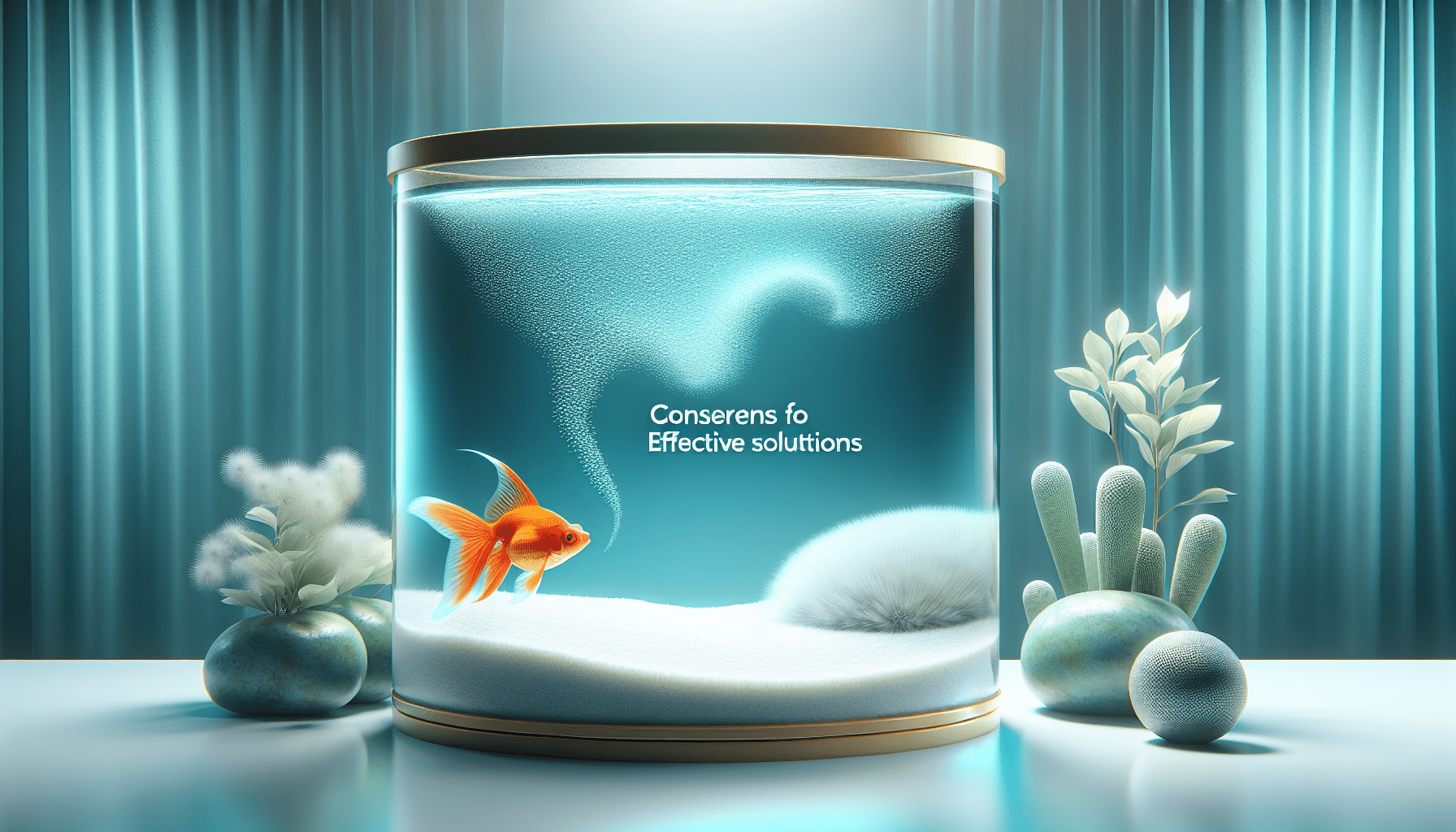If you’ve ever had a fish tank, then you know the frustration that comes with dealing with foaming or biofilm. Whether you’re a seasoned fish enthusiast or new to the hobby, finding a solution to this common issue can be a challenge. Thankfully, there are simple yet effective methods to tackle foaming or biofilm in your fish tank. In this article, we’ll walk you through some easy steps to help you maintain a clean and healthy environment for your finned friends. So, let’s dive in and bid farewell to foaming and biofilm woes!
Causes of Foaming or Biofilm in Fish Tanks
Excess Protein
One of the common causes of foaming or biofilm in fish tanks is the presence of excess protein. When you feed your fish, uneaten food or fish waste often contain high levels of protein. If not properly removed or broken down, the excess protein can accumulate and create a foamy or slimy layer on the water’s surface.
Overfeeding
Overfeeding is another factor that can contribute to the development of foaming or biofilm in fish tanks. When you exceed the recommended feeding amount for your fish, the excess food can break down and produce higher nutrient levels in the water. This excess nutrient load can promote the growth of bacteria, which can manifest as foam or biofilm.
Inadequate Filtration
An inadequate filtration system can also play a role in the formation of foaming or biofilm in fish tanks. The filtration system is responsible for removing organic wastes, excess nutrients, and other impurities from the water. If the filtration system is not efficient or properly maintained, it can lead to a buildup of organic matter, creating an environment conducive to the growth of foam or biofilm.
Stagnant Water
Poor water circulation or stagnant water can contribute to the formation of foaming or biofilm in fish tanks. Stagnant water can restrict the oxygen exchange and the movement of organic particles in the tank, allowing debris and waste to accumulate on the water’s surface. This stagnant environment can provide the ideal conditions for the development of foaming or biofilm.
Effects of Foaming or Biofilm in Fish Tanks
Reduced Oxygen Levels
Foaming or biofilm in fish tanks can result in reduced oxygen levels in the water. The layer of foam or biofilm can restrict the exchange of gases between the water and the air, leading to lower oxygen levels in the tank. This oxygen deprivation can have detrimental effects on the health and well-being of your fish, potentially causing stress or even suffocation.
Poor Water Quality
The presence of foaming or biofilm in fish tanks is often indicative of poor water quality. The accumulation of organic matter and excess nutrients can lead to imbalances in the tank’s ecosystem, resulting in high ammonia, nitrite, or nitrate levels. Poor water quality can stress your fish, making them more susceptible to diseases and other health issues.
Bad Aesthetic Appearance
In addition to the negative effects on water parameters and fish health, foaming or biofilm in fish tanks can also detract from the overall aesthetic appearance of your aquarium. The presence of a foamy or slimy layer on the water’s surface can make your tank appear dirty, unkempt, and unattractive. It can diminish the visual appeal of your fish and the enjoyment of observing your underwater pets.

This image is property of images.pexels.com.
Methods to Prevent Foaming or Biofilm in Fish Tanks
Proper Protein Levels
To prevent the formation of foaming or biofilm in your fish tank, it is essential to maintain proper protein levels. Ensure that you are not overfeeding your fish and monitor the amount of protein-rich food you provide. Avoid excess protein build-up by feeding your fish only what they can consume within a few minutes.
Regular Feeding Schedule
Establishing a regular feeding schedule can help prevent the accumulation of excess organic matter and nutrients in your tank. By feeding your fish at the same time each day and avoiding excessive or irregular feeding, you can minimize the risk of foaming or biofilm development. Remember to remove any uneaten food promptly to prevent it from decomposing and contributing to water quality issues.
Efficient Filtration System
Investing in a high-quality filtration system and ensuring its efficient operation is crucial for preventing the onset of foaming or biofilm. Choose a filter suitable for your tank size and fish population, and maintain regular maintenance and cleaning routines as recommended by the manufacturer. This will help remove organic waste and excess nutrients from the water, preventing their accumulation and the formation of foam or biofilm.
Maintaining Water Flow
Promote proper water circulation and flow within your fish tank to prevent stagnation and the accumulation of debris. Consider utilizing powerheads, air stones, or adjustable filters to maintain steady water movement. By keeping the water flowing, you can minimize the chances of foam or biofilm formation and help maintain optimal water quality for your fish.
Methods to Remove Foaming or Biofilm in Fish Tanks
Reducing Protein Buildup
If you notice foaming or biofilm in your fish tank, reducing protein buildup is a crucial step in addressing the issue. By adjusting your feeding habits and providing only the necessary amount of protein for your fish, you can gradually eliminate the excess protein that contributes to foam or biofilm formation.
Cleaning the Surface of the Water
In cases where foaming or biofilm is already present, manually cleaning the surface of the water can help remove the visible layer. Gently skim a fishnet or paper towel across the water’s surface to collect the foam or biofilm, being careful not to disturb the fish or introduce further contaminants.
Installing a Protein Skimmer
Consider installing a protein skimmer in your fish tank to effectively remove excess proteins and organic compounds before they have a chance to accumulate and lead to foaming or biofilm. Protein skimmers work by creating a column of bubbles that attract and trap proteins, resulting in their removal from the water.
Using Chemical Treatments
In severe cases where other methods have failed, you may consider using chemical treatments specifically designed to address foaming or biofilm in fish tanks. However, exercise caution when using these treatments, as some can be harmful to fish, invertebrates, or beneficial bacteria. Follow the instructions carefully and perform thorough research before introducing any chemicals into your tank.

This image is property of images.pexels.com.
Natural Remedies for Foaming or Biofilm in Fish Tanks
Adding Floating Plants
Adding floating plants, such as duckweed or water lettuce, to your fish tank can help combat foaming or biofilm naturally. These plants absorb excess nutrients from the water, reducing the nutrient levels that contribute to the formation of foam or biofilm. Additionally, floating plants provide shade and shelter, promoting a healthier and more balanced ecosystem.
Introducing Snails or Shrimp
Snails or shrimp, such as Malaysian trumpet snails or amano shrimp, can serve as natural cleaners in your fish tank. These organisms help consume organic matter, excess food, and other debris, preventing their accumulation and the subsequent development of foam or biofilm. They can be beneficial additions to your aquarium’s cleaning crew.
Regular Water Changes
Performing regular water changes is crucial in maintaining a healthy environment and preventing the formation of foaming or biofilm. By removing a portion of the water and replacing it with fresh, conditioned water, you can dilute the concentration of contaminants and maintain optimal water quality for your fish.
Increasing Aeration
Increasing aeration in your fish tank can help alleviate foaming or biofilm issues. By providing ample oxygenation through the use of air stones, diffusers, or surface agitation, you promote better water quality and discourage the growth of foam or biofilm. Increased aeration supports a healthier and more vibrant ecosystem for your fish.
Proper Tank Maintenance to Prevent Foaming or Biofilm
Regular Water Testing
Regularly test the water parameters in your fish tank to ensure proper maintenance and prevent the formation of foaming or biofilm. Monitor ammonia, nitrite, nitrate, pH, and other relevant parameters to catch any imbalances early and address them accordingly. Proper water testing allows you to maintain a suitable environment for your fish.
Cleaning the Tank and Equipment
Perform routine cleaning of your fish tank and equipment to prevent the buildup of organic matter and debris. Regularly vacuum the gravel or substrate, clean the aquarium glass, and remove any visible waste or uneaten food. Additionally, ensure that your filtration system and other equipment are clean and functioning optimally.
Avoid Overstocking
Avoid overstocking your fish tank, as it can lead to increased waste production and an imbalance in the tank’s ecosystem. Ensure that the number and size of fish in your tank are suitable for its capacity and maintain a healthy bio-load. Overstocking can contribute to excessive organic matter, making it harder to prevent foaming or biofilm.
Providing Adequate Lighting
Proper lighting is crucial for maintaining a healthy fish tank environment and preventing the formation of foaming or biofilm. Ensure that your tank receives an appropriate amount of light suitable for your fish and plant species. Too much or too little light can disrupt the balance in the tank and contribute to the growth of unwanted organisms.

This image is property of images.pexels.com.
Additional Tips for Dealing with Foaming or Biofilm
Avoid Using Soaps or Detergents
When cleaning your fish tank or any equipment, always avoid using soaps or detergents. These substances can be toxic to fish and other aquatic organisms, and even small traces left behind can disrupt the tank’s delicate ecosystem. Use only clean water or specifically approved aquarium-safe cleaning products.
Avoid Excessive Water Additives
Although water additives can be helpful in certain situations, it is essential to avoid excessive use. Overusing conditioners, clarifiers, or other water treatments can upset the water balance and potentially contribute to the formation of foaming or biofilm. Follow the recommended dosage instructions and use additives sparingly and only when necessary.
Remove Excess Organic Matter
Regularly remove excess organic matter from your fish tank to prevent the accumulation of waste and nutrient-rich debris. Trim dead or decaying plant matter, remove any uneaten food, and perform routine maintenance to keep your tank clean. By minimizing organic waste, you can help reduce the likelihood of foaming or biofilm development.
Monitor Fish Behavior
Pay close attention to the behavior and appearance of your fish. Changes in their activity levels, appetite, or overall well-being can indicate underlying problems in the tank, including foaming or biofilm issues. Promptly address any irregularities or signs of distress to mitigate potential problems and maintain a healthy environment.
Dealing with Foaming or Biofilm in Different Types of Fish Tanks
Freshwater Fish Tanks
Many of the methods and tips mentioned earlier apply to freshwater fish tanks. Maintaining suitable protein levels, regular feeding schedules, efficient filtration, and adequate water flow are essential in preventing and addressing foaming or biofilm in these tanks. Additionally, consider incorporating freshwater plants and algae-eating fish, like plecos or algae eaters, to naturally control excess nutrients and contribute to a healthier ecosystem.
Saltwater Fish Tanks
Saltwater fish tanks may require additional precautions and maintenance due to the increased complexity of the marine environment. It is crucial to maintain stable salinity, excellent water quality, and proper reef or coral health. Good protein skimming, effective filtration, and regular water changes are vital to prevent and manage foaming or biofilm issues in saltwater tanks.
Planted Fish Tanks
Planted fish tanks benefit from the natural filtration capabilities of aquatic plants. A well-balanced ecosystem with thriving plants helps absorb excess nutrients, leading to less foaming or biofilm. Ensure proper plant care, including pruning and nutrient supplementation, to promote plant growth and prevent nutrient imbalances that can contribute to foaming or biofilm.
Reef Aquariums
Reef aquariums require meticulous care and attention to maintain the delicate balance of corals, invertebrates, and fish. The prevention and management of foaming or biofilm in reef aquariums involve stringent water quality control, efficient protein skimming, stable lighting, and long-term tank stability. Regular monitoring and regular water testing are crucial in these complex ecosystems.

Consulting an Expert for Persistent Foaming or Biofilm
Seeking Advice from a Veterinarian
If you have tried various methods and still struggle with persistent foaming or biofilm issues, it may be beneficial to seek advice from a veterinarian experienced in fish health. They can perform diagnostic tests, assess your tank’s unique circumstances, and provide targeted recommendations to address the underlying causes of the problem.
Contacting a Professional Aquarist
Professional aquarists who specialize in fish tank maintenance and management can offer valuable guidance when dealing with persistent foaming or biofilm. They can assess your tank setup, provide expert analysis, and offer customized solutions to address the issue effectively. Their experience and knowledge can help you optimize your tank’s conditions and prevent future problems.
Joining Fish Keeping Communities
Joining online or local fish keeping communities can be a valuable resource when dealing with foaming or biofilm issues. Other hobbyists and experienced aquarists can offer advice, share their experiences, and provide guidance based on their firsthand knowledge. Interacting with fellow fish keepers can enhance your understanding of fish tank management and help you tackle foaming or biofilm challenges more effectively.
Dealing with foaming or biofilm in fish tanks requires patience, regular maintenance, and a thorough understanding of the underlying causes. By implementing preventive measures, addressing the root causes promptly, and maintaining a healthy tank ecosystem, you can ensure a clean and thriving environment for your fish to flourish.


